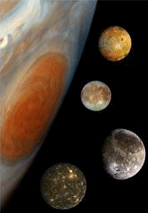 |
It was already evident from Kepler's laws of planetary motion that some force must be generated by the Sun and act on the planets. Isaac Newton (1643-1727) from England provided a theoretical framework to understand this force, in the form of a universally valid mechanical principle (Newton's law of gravitation): Two massive bodies attract each other with a force F proportional to the product of their masses
F = G*m1*m2 / r^2
Special Types of StarsBinary and multiple stars as well as variables. Giovanni Batista Riccioli of Bologna discovered the nature of Mizar (Zeta Ursae Majoris) as a double star in 1650. While suddenly occurring "new stars" (novae and supernovae) had been occasionally recorded through the centuries from various cultures, it was only Tychos supernova of 1572 and Kepler's from 1604, as well as the nova-like outburst of P Cygni in 1600, discovered by W.J. Blaeu, that became generally known for western astronomers.
Stellar Photometry
Until early 19th century, stellar magnitudes were estimated approximately and inacurately by visual observers, to at most 0.2 magnitudes accuracy. In 1861, Karl Friedrich Zöllner (1834-82) in Berlin introduced the visual photometer. Further improvement was achieved by introducing photoelectric cells for photometry, and by measuring photographic plates.
Spectroscopy
Already in 1666, Isaac Newton had shown that sunlight can be decomposed into a spectrum when passing a prism. Christian Doppler (1803-53) had discovered that moving bodies show shifted spectral lines, so that radial velocities can be determined spectroscopically with high accuracy. William Huggins stated in 1868 that, because of this effect, spectral lines of moving celestial objects should appear shifted. The power of photography for every branch of astronomy was quickly demonstrated.
The essential event marking the discovery of gaseous nebula came when William Huggins observed their spectra in 1864 and found them to be emission line spectra. Now there was a simple and unique criterion distinguishing them from star clusters, which like the stars composing them, show a continuous spectrum (with overlaid absorption and sometimes emission lines). Spiral "nebulae", however, show continuous spectra like stars. It was known since Herschel that the Milky Way forms a system of stars one of which is our Sun. Since Kant and Herschel, it was speculated that there might be other similar stellar systems.
Galactic Radiation
As early as 1800, William Herschel discovered the infrared radiation beyond the red end of the visible spectrum with a thermometer.
 |
Albert Einstein
Einstein wrote four fundamental papers in 1905, all in a few months. The first paper claimed that light must sometimes behave like a stream of particles with discrete energies, "quanta." The second paper offered an experimental test for the theory of heat and proof of the existence of atoms. The third paper addressed a central puzzle for physicists of the day – the connection between electromagnetic theory and ordinary motion – and solved it using the "principle of relativity." The fourth showed that mass and energy are two parts of the same thing, mass-energy (E=mc2). In 1915, Einstein completed his Gravitation and the General Theory of Relativity. Overturning ancient notions of space and time, he reached a new understanding of gravity. In 1918, the general theory of relativity received stunning confirmation from British astronomers: as Einstein had predicted, gravity bends starlight. In 1924, Einstein contributed to the struggling new quantum theory, and searched for a way to unify the theories of electromagnetism and gravity. In 1929 he announced a unified field theory, but the mathematics were not consistent with experiments.
History of Modern Astronomy, Astronomy 101 - Modern Astronomy, Development of Modern Astronomy, HET606 Tools of Modern Astronomy, Charge-coupled device, The Telescope: Hubble Essentials, Radio telescope, National Radio Astronomy Observatory, Black hole, Expanding Universe, Big Bang, Big Bang Theory, THE BIG BANG